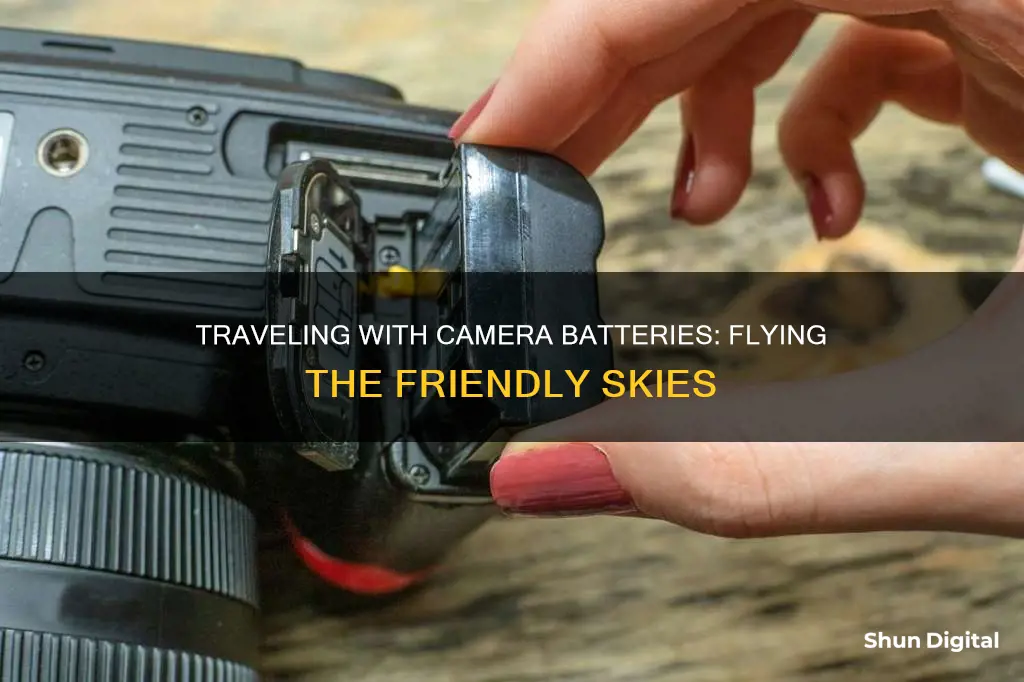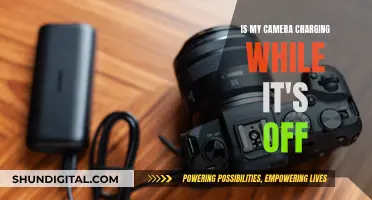
Flying with camera equipment can be a daunting task, especially when it comes to batteries. Lithium-ion batteries, which are commonly used in cameras, are considered dangerous goods due to their potential to short-circuit or catch fire. As a result, there are strict guidelines for carrying them on planes. Here's a guide to help you navigate the rules and regulations for flying with camera batteries.
First, it's important to note that lithium-ion camera batteries are allowed on planes, but they must be stored in carry-on luggage. This is because, in the event of a fire, having batteries in the cargo hold could pose a greater threat without anyone there to put it out. Each airline may have its own specific rules, so it's always a good idea to check with your airline before your trip.
When packing lithium-ion camera batteries, it's crucial to take precautions to prevent short circuits. You can do this by keeping them in their original packaging or taping over the charging interface or terminals. Additionally, make sure the batteries are protected from damage and kept separate from other metal items.
There are also limits to the number and capacity of batteries you can carry. Passengers are typically allowed to bring two spare lithium-ion camera batteries, each with a capacity of up to 100 watt-hours (Wh). If you need to bring larger batteries (between 101 and 160 Wh), you may be permitted to carry up to two of them, but this may require permission from the airline.
To avoid any issues at the airport, it's recommended to package your batteries properly. This can include keeping them in their original boxes or using tape to secure the contacts. Travelling with media badges, getting TSA pre-check, and having a REAL ID can also make the process smoother.
Lastly, it's important to never fly with damaged batteries. If a battery shows any signs of swelling or leakage, dispose of it properly and replace it before your trip.
What You'll Learn
- Lithium-ion batteries are allowed in carry-on luggage if under 100Wh
- Tape over charging interfaces or connectors to avoid short circuits
- Keep batteries in original packaging or separate bags to avoid contact
- Only two spare lithium-ion camera batteries are allowed on the plane
- Damaged batteries should be disposed of and not taken on the plane

Lithium-ion batteries are allowed in carry-on luggage if under 100Wh
Lithium-ion batteries are considered dangerous goods due to their potential to short-circuit or catch fire. As a result, there are strict guidelines for carrying them on planes. However, you can carry lithium-ion batteries in your carry-on luggage if they are under 100Wh. This rule applies to both lithium-ion and lithium metal batteries, including power banks and cell phone battery charging cases. These batteries must be carried in carry-on baggage only and should not be included in checked luggage.
It is important to note that the battery terminals must be protected from short circuits. This can be done by leaving the batteries in their retail packaging, covering the terminals with tape, using a battery case, or placing them in a plastic bag or protective pouch. Additionally, passengers are advised to carry their batteries with them in the aircraft cabin even when their carry-on bag is checked at the gate or planeside.
To ensure compliance with airline regulations, it is recommended to check with your airline before your trip. The Federal Aviation Administration (FAA) and the Transportation Security Administration (TSA) in the United States, and the International Air Transport Association (IATA) internationally, provide guidelines and regulations for carrying batteries on planes. These regulations are subject to change, so it is important to stay informed about the latest rules.
When packing lithium-ion batteries for air travel, it is crucial to prioritize safety. Damaged, swollen, or leaking batteries should not be brought on board and must be disposed of properly. To prevent issues during security screening, passengers should be prepared for additional inspections and have their batteries easily accessible.
Charging the Floureon Camera: A Step-by-Step Guide
You may want to see also

Tape over charging interfaces or connectors to avoid short circuits
When flying with camera batteries, it's important to take precautions to avoid short circuits and potential fires. One effective way to do this is by taping over the charging interfaces or connectors of your batteries. Here are some detailed instructions and tips on how to do this:
Firstly, it's crucial to use the right type of tape. Avoid using parcel tape, as it will leave marks on your batteries. Instead, opt for camera tape, which won't leave any sticky residue. Electrical tape is also mentioned by some sources as a suitable option.
When taping your battery terminals, make sure to cover the connectors or interfaces completely. This will prevent accidental contact and reduce the risk of short circuits. It's also a good idea to store the batteries in separate bags for added safety.
In addition to taping the terminals, you can also use the original packaging or a protective case to shield the batteries from potential damage. This will provide an extra layer of protection and make it easier to transport your batteries safely.
By taking these simple steps, you can help ensure the safe transportation of your camera batteries when flying. It's also important to note that regulations and guidelines for flying with batteries may vary, so be sure to check with your airline and relevant authorities before your trip.
Kodak Camera Not Charging: Troubleshooting Guide
You may want to see also

Keep batteries in original packaging or separate bags to avoid contact
When flying with camera batteries, it is important to keep them in their original packaging or in separate bags to avoid contact with metal objects such as coins, keys, or jewellery. This is because batteries can short-circuit and overheat, which can cause sparks or even a fire. By keeping them in their original packaging or in separate bags, you can reduce the risk of a short circuit.
- Keep batteries in their original retail packaging whenever possible. This will help prevent unintentional activation or short-circuiting.
- If the original packaging is not available, place each battery in its own protective case, plastic bag, or package. This will help to insulate the battery terminals and prevent spare batteries from coming into contact with other batteries or metal objects.
- Tape across the battery's contacts to isolate the terminals and prevent short-circuiting. This is especially important if you are unable to keep the batteries in their original packaging or separate bags.
- Take steps to prevent crushing, puncturing, or putting pressure on the batteries, as this can cause an internal short circuit and result in overheating.
- If you are travelling with a large number of batteries, distribute them across multiple bags to reduce the risk of contact between them.
- Follow the guidelines provided by the airline and airport security to ensure compliance with safety regulations.
By following these guidelines, you can help ensure the safe transportation of camera batteries and reduce the risk of accidents during your flight.
GoPro Charging Time: How Long Until Your Camera's Ready?
You may want to see also

Only two spare lithium-ion camera batteries are allowed on the plane
When flying with camera equipment, it's important to be aware of the rules and regulations regarding batteries. Lithium-ion camera batteries are considered dangerous goods due to their potential to short-circuit or catch fire. Here are some detailed instructions and tips to ensure you comply with the regulations and safely transport your camera batteries on your next flight:
Know the Rules:
Prepare Your Batteries:
Before your trip, inspect your camera batteries for any damage, such as swelling or leakage. Do not bring damaged batteries on board. Instead, dispose of them properly and purchase new ones. To prevent short circuits, cover the battery terminals with electrical tape, or use the packaging provided by the manufacturer. You can also store them in their original packaging or a protective case to avoid accidental activation and for easy identification during customs checks.
Carry-On vs Checked Baggage:
Always carry your camera batteries with you in your carry-on luggage. Do not put them in checked baggage, as they could pose a fire hazard in the cargo hold. Keep them in your carry-on bag, where you can monitor them and quickly address any issues. This also reduces the risk of lost or damaged batteries during transit.
Additional Tips:
- To avoid delays at security checkpoints, consider obtaining a media badge, TSA pre-check, or a REAL ID, which can expedite the screening process and reduce scrutiny of your equipment.
- If you have multiple batteries, consider using a small zipper case to organise and secure them. Label the case clearly to indicate the type of batteries inside.
- If possible, keep your batteries in their original packaging or use plastic bags to separate them and prevent contact with other metal items.
- Be mindful of weight restrictions for carry-on luggage. Camera equipment can be heavy, so distribute the weight across your carry-on bags and utilise your jacket pockets for smaller items like batteries and lenses.
Charging Your ADT Doorbell Camera: Quick and Easy Steps
You may want to see also

Damaged batteries should be disposed of and not taken on the plane
When flying with camera equipment, it's important to keep your gear safe, comply with airline regulations, and ensure you're not putting yourself or others in danger. Lithium-ion camera batteries, in particular, require careful handling as they are considered hazardous materials due to their potential to short-circuit or catch fire.
Damaged batteries should never be taken on a plane. If a battery shows any signs of damage, such as bloating, swelling, cracks, corrosion, leaking, or burn marks, it must be disposed of properly. Damaged lithium-ion batteries can pose a serious safety risk as they may leak toxic chemicals and become a fire hazard.
When disposing of damaged lithium-ion batteries, it is crucial to follow proper safety procedures. Here are some general guidelines:
- Isolate the damaged battery: Remove the battery from the device if possible and keep it away from people and other combustible materials.
- Wear protective gear: Put on gloves, goggles, a face shield, and an apron to protect yourself from toxic chemicals and potential sparks.
- Place the battery in a non-combustible container: Use a container made of non-flammable, electrically non-conductive, and absorbent material. This will help contain any leaks and reduce the risk of fire.
- Tape the battery terminals: Cover the charging interfaces or connectors with tape to prevent accidental activation and short circuits.
- Do not dispose of batteries in regular trash or recycling bins: Lithium-ion batteries should never be placed in regular trash or recycling bins as they can pose a risk to waste management staff and equipment.
- Contact a recycling professional: Reach out to a battery recycling company or your local waste management facility for guidance on proper disposal. They may have specific procedures or requirements for handling damaged batteries.
- Store swollen batteries safely: If a battery is swollen, store it in an open-top metal, ceramic, or glass container, keeping it away from heat sources, combustible materials, and children.
- Be aware of hazardous waste guidelines: Some locations may have specific guidelines for hazardous waste disposal, so check with your local waste management authorities.
By following these guidelines, you can help ensure the safe disposal of damaged lithium-ion camera batteries and reduce the risk of fire or other hazards. Remember, damaged batteries should never be taken on a plane, and proper disposal procedures must always be followed to protect yourself and others.
Charging Camera Batteries: A Step-by-Step Guide
You may want to see also
Frequently asked questions
Yes, you can fly with camera batteries in your carry-on luggage. However, there are some restrictions. For example, you can only carry two spare lithium-ion camera batteries, and they must be protected from damage and short circuits.
The weight limit for camera batteries when flying depends on the type of battery. Lithium-ion batteries under 100Wh are typically allowed, while batteries between 101 and 160Wh may be permitted with airline permission.
When packing camera batteries for air travel, it is important to protect them from damage and short circuits. You can do this by keeping them in their original packaging or using tape to cover the charging interface or terminals.
Yes, there are some restrictions on flying with lithium-ion camera batteries. In addition to the weight limits mentioned above, you should also check the specific rules of your airline, as they may have their own limitations.







